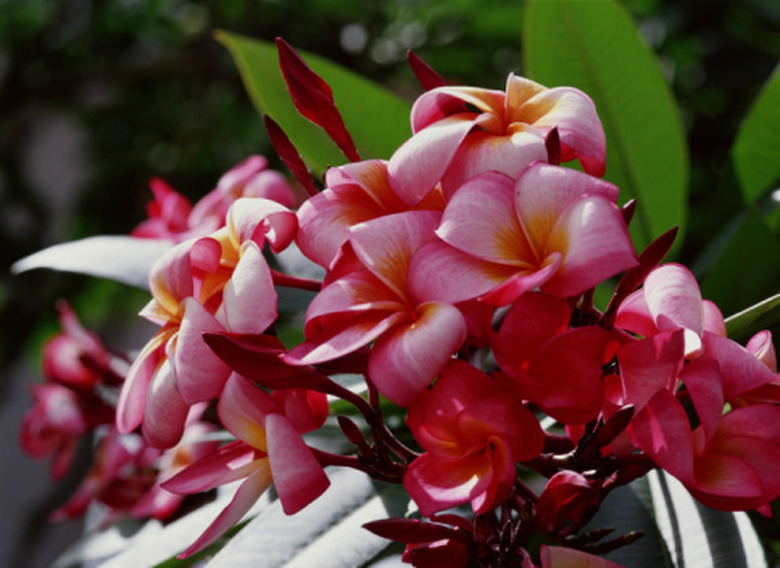Bugs On Plumeria Plants
Plumeria are tropical trees with dark green leathery leaves and white, yellow or pink flowers that are known for their heady fragrance. Although they can grow 20 feet tall or higher in the wild, gardeners often control their size by planting them in pots. Plumeria are easy to grow, but many bugs attack them.
Scales
Scales, such as the green shield scale that attacks plumeria, are odd-looking insects. The females and most nymphs are wingless and lack identifiable body parts. In addition, they don't move. Young females are green, older ones are brown. Both have oval bodies. Scales damage plumeria by sucking the fluids from the leaves and other plant parts. Plants infested with scales have curled or blemished leaves, or wilted, yellow leaves that drop early. Control severe scale infestations by spraying your plumeria with narrow-range horticultural oil.
- Plumeria are tropical trees with dark green leathery leaves and white, yellow or pink flowers that are known for their heady fragrance.
- Plants infested with scales have curled or blemished leaves, or wilted, yellow leaves that drop early.
Mealybugs
Mealybugs are soft-bodied pinkish or yellowish insects related to scales. They grow to 1/8 inch-long and are usually covered with white, wooly filaments. Mealybugs suck sap from plumeria leaves, causing them to look discolored, wilted and malformed. Remove infected leaves and discard them. Use a strong spray of water to remove bugs from your plant.
Whiteflies
Whiteflies are winged insects that resemble tiny moths. Whitefly nymphs are wingless, with small, oval bodies and no obvious legs. Both adults and nymphs damage plumeria plants by sucking plant sap from the leaves and stems. Whiteflies don't usually kill plants but weaken them. Control this pest by washing bugs off leaves with a strong stream of water. Remove infested leaves and seal them in plastic bags before discarding them.
- Mealybugs are soft-bodied pinkish or yellowish insects related to scales.
- Mealybugs suck sap from plumeria leaves, causing them to look discolored, wilted and malformed.
Caterpillars
Frangipani caterpillars are the larvae of the tetrio sphinx moth. They're black with yellow rings and have a reddish-orange head and a black horn on the eighth body segment. These caterpillars grow to 6 inches long and can eat three large leaves every day. Trees don't suffer permanent damage from their feeding, even when a tree is completely defoliated. Control these caterpillars by handpicking them off the leaves.
Beetles
Plumeria stem borers are the larvae of the long horned beetle. This pest damages plumerias from inside their stems. Symptoms include small holes in the stems from which a black liquid oozes. Insecticides don't work against this pest. Remove affected plant parts and destroy them.
- Frangipani caterpillars are the larvae of the tetrio sphinx moth.
- These caterpillars grow to 6 inches long and can eat three large leaves every day.
Thrips
Thrips are tiny, winged insects less than 1/20 inch long. Thrips can be white, yellowish, dark brown or black, depending on the species. Thrips attack buds and leaves of plumeria trees, causing discolored and distorted tissues. The leaves become papery, and tiny scars form on them. Buds become deformed and brown streaks and spots appear on the petals. Thrip infestations don't usually kill plants unless the population is high. Overusing pesticides destroys the natural enemies of thrips and isn't recommended. Controlling dust around your plumeria tree eliminates thrips.
- Thrips are tiny, winged insects less than 1/20 inch long.
- Thrip infestations don't usually kill plants unless the population is high.
Mites
Spider mites are major pests of plumeria. Symptoms include blistered tissue, deformed leaves and the appearance of dead spots on the leaves, leaf drop and shoot tip dieback. Sometimes, a yellow stripe appears down the midrib of a leaf. Webbing also appears on the leaf. Spider mites are tiny bugs that are hard to without a magnifying glass. The damage they cause is a result of their feeding on plant juices. Control them with a light horticultural oil spray, insecticidal soaps or a miticide.
- Spider mites are major pests of plumeria.
- Symptoms include blistered tissue, deformed leaves and the appearance of dead spots on the leaves, leaf drop and shoot tip dieback.
